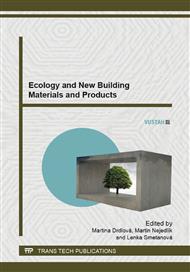[1]
H. Akahane, T. Furuno, H. Miyajima, T. Yoshikawa, S. Yamamoto, Rapid wood silicification in hot spring water: an explanation of silicification of wood during the Earth's history, Sedimentary Geology Vol. 169 (2004), p.219 – 228.
DOI: 10.1016/j.sedgeo.2004.06.003
Google Scholar
[2]
J. Daňková, L. Reinprecht, T. Murínová, P. Mec, M. Pánek, L. Plevová, Performance of methyl-tripotassiumsilanol treated wood against swelling in water, decay fungi and moulds, Wood Research Vol. 58 (2013), p.511 – 520.
Google Scholar
[3]
D. Horský, L. Reinprecht, Štúdia subfosilného dubového dreva (Studies of subfosil oak wood), VŠLD Zvolen, Zvolen, (1986).
Google Scholar
[4]
K. Kim, E. K. Jeong, M. Suzuki, M. Huh, I. S. Paik, Some coniferous fossil woods from the Cretaceous of Korea, Geosciences Journal Vol. 6 (2002), p.131 – 140.
DOI: 10.1007/bf03028284
Google Scholar
[5]
K. W. Kim, Ch. J. Yoon, P. G. Kim, M. B. Lee, J. H. Lim, Fine structure and X-ray microanalysis of silicified woods from a Tertiary basin Pohang, Korea by scanning electron microscopy, Micron Vol. 40 (2009), p.519 – 525.
DOI: 10.1016/j.micron.2009.04.006
Google Scholar
[6]
M. Mamoňová, Wood anatomy, Technical University in Zvolen, Zvolen, (2013).
Google Scholar
[7]
A. Požgaj, D. Chovanec, S. Kurjatko, M. Babiak, Štruktúra a vlastnosti dreva (Structure and properties of wood), PRÍRODA, Bratislava, (1997).
Google Scholar
[8]
L. Reinprecht, Ochrana dreva (Protection of wood), Technical University in Zvolen, Zvolen, (2004).
Google Scholar
[9]
F. Simon, F. Marchal, F. Pochon, M. Kutnik, I. La Bayon, The potential of silicone-based formulations to enhance wood properties through industrial treatment for outdoor use, The International Research Group on Wood Protection, Sweden, (2011).
Google Scholar
[10]
A. A. Snelling, 'Instant', petrified wood, Creation Vol. 17 (1995), p.38 – 40.
Google Scholar
[11]
Ch. J. Yoon, K. W. Kim, Anatomical descriptions of silicified woods from Madagascar and Indonesia by scanning electron microscopy, Micron Vol. 39 (2008), pp.825-831.
DOI: 10.1016/j.micron.2007.12.011
Google Scholar


